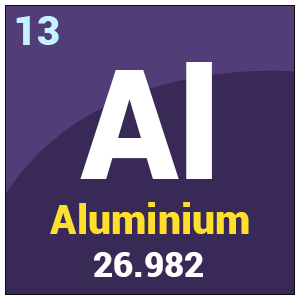
| Symbol of aluminium | Al |
| Atomic Number of aluminium | 13 |
| Atomic Mass of aluminium | 26.98 amu |
| Discovered by | Hans Christian Oersted in 1825 |
The Atomic Mass of aluminium is 26.98 amu.
Table of Contents
Element Information
| Group | 13 | Melting point | 660.323°C, 1220.581°F, 933.473 K |
| Period | 3 | Boiling point | 2519°C, 4566°F, 2792 K |
| Block | p | Density (g cm−3) | 2.70 |
| Atomic number | 13 | Relative atomic mass | 26.982 |
| State at 20°C | Solid | Key isotopes | 27Al |
| Electron configuration | [Ne] 3s23p1 | CAS number | 7429-90-5 |
| ChemSpider ID | 4514248 | ChemSpider is a free chemical structure database | |
What is Aluminium?
Aluminium is a soft, silvery-white, ductile, nonmagnetic metal in the boron group.
It is the third most abundant element in the Earth’s crust. Depending on the surface reference, aluminium appears in the range from silvery to dull grey.
Properties of Aluminium
Various physical properties of aluminium have been discussed below:
- The element is highly reactive. It has about one-third of stiffness and density of steel.
- Aluminium has good corrosion resistivity.
- It is capable of superconductivity.
- They are many unknown isotopes of hydrogen with the mass number ranging from twenty-one to forty-one.
Chemical Properties of Aluminium
1. Aluminum Reaction with HCl
Aluminum reacts with dilute hydrochloric acid at room temperature. The metal aluminium dissolves in hydrochloric acid, producing aluminum chloride and colorless hydrogen gas. The reaction taking place between aluminium and hydrochloric acid is irreversible.
2Al + 6HCl → 2AlCl₃ + 3H₂↑
2. Aluminum Reaction with Sodium hydroxide
Sodium aluminate is also formed by the action of sodium hydroxide on elemental aluminium which is an amphoteric metal. The reaction is highly exothermic once established and is accompanied by the rapid evolution of hydrogen gas.
2NaOH + 2H2O → 2NaAlO2 + 3H.
3. Aluminum Reaction with water
Aluminum metal rapidly develops a thin layer of aluminum oxide of a few millimeters that prevents the metal from reacting with water. Aluminium reacts with water to produce hydrogen gas according to the equation.
Uses of Aluminium
- It is used in the transportation of railway, trucks, automobiles as castings.
- It is used in packaging.
- Al(II) compounds are observed in the reactions of Al metal with oxidants.
- Using aluminon the presence of aluminium can be detected in qualitative analysis.
Frequently Asked Questions – FAQs
Is aluminium a metal?
Aluminium is a silvery-white, lightweight metal. It is soft and malleable. Aluminium is used in a huge variety of products including cans, foils, kitchen utensils, window frames, beer kegs and aeroplane parts. It is the second most malleable metal and the sixth most ductile.
Why is steel cheaper than aluminium?
Aluminum is much more expensive than carbon steel. Repairing aluminum is also more expensive than repairing steel. Steel’s carbon content makes it harder, more dent resistant, and more durable when stressed. Steel is strong and less likely to warp, deform or bend under weight, force or heat.
What are the three properties of aluminum?
This is because of its particular properties. It has low density, is non-toxic, has a high thermal conductivity, has excellent corrosion resistance and can be easily cast, machined and formed. It is also non-magnetic and non-sparking. It is the second most malleable metal and the sixth most ductile.
What is the main useful property of Aluminium alloys?
Pure aluminium is soft, ductile, corrosion resistant and has a high electrical conductivity. It is widely used for foil and conductor cables, but alloying with other elements is necessary to provide the higher strengths needed for other applications.
What are the two classifications of aluminum alloys?
There are two principal classifications, namely casting alloys and wrought alloys, both of which are further subdivided into the categories heat-treatable and non-heat-treatable.
Recommended Videos

Frequently asked questions
1. Who discovered aluminium?
Ans: Hans Christian Orsted.
2. What is the atomic mass of aluminium?
Ans: The atomic mass of aluminium is 26.98 amu.
3. Aluminium belongs to which period?
Ans: 3.
4. Aluminium belongs to which group?
Ans: Aluminium is a group 13 element.
5. Aluminium is a ____ block element.
Ans: p.
Read more:




Comments